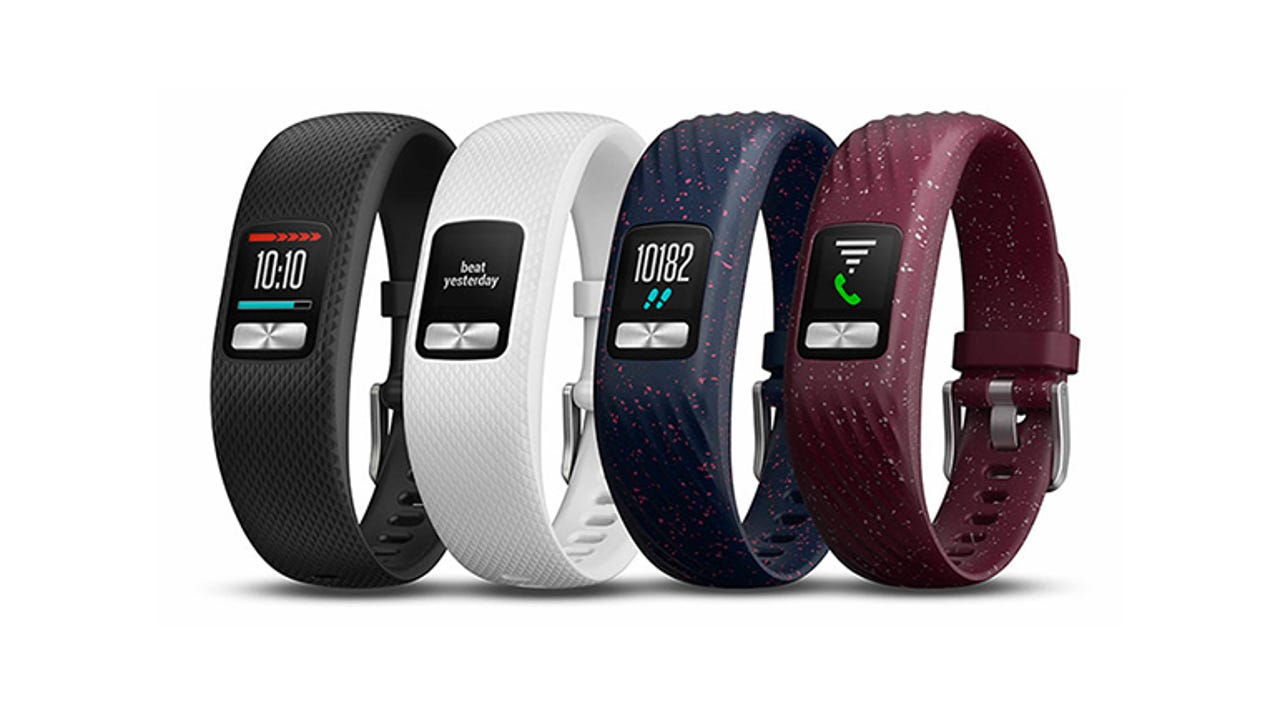Garmin Vivofit 4, First Take: Great battery life, but no heart-rate monitoring


The most significant feature of the £69.99 (inc. VAT) Garmin Vivofit 4 is probably the year-long battery life from its user-replaceable SR43 batteries. This means there's no need to carry a charge cable. As a regular wearer of activity trackers since they first became available, this has been a very long time coming, and it's fabulous that it's finally arrived. How nice it is to go away for a week and not have to pack a proprietary charge cable for my wristband.
The general build quality is fine, if a bit on the basic side. The one-piece rubbery band is snug enough on the wrist, and my review sample was black with lime-green specks and spots. Plain black and white options are also available, both with a textured finish.
The 8-colour screen is very small at just 11mm and 88 pixels square. The display is always on, so it's easy to see the time whenever you want to -- provided you can manage with the small screen (I found it just too tiny for convenient glances).
Beneath the screen is a large and very responsive button that moves through the metrics the band collects -- including steps, calories and distance travelled -- as well as giving access to stopwatch features. There's a bit of messing about with long and short presses to get used to, which I found quite irritating if I sped past the required option and had to go all the way round the cycle again.
Upload data from the Vivofit 4 to the Garmin Connect app, where you can view and share a wealth of fitness information.
There's a sleep-tracker element whose recorded data you can access through the Garmin Connect app. You'll also need this to pick a different watch face and colour theme for the Vivofit 4, set move alerts and alarms, and to see historical data, although the Vivofit 4 itself can store four weeks of activity. You can also turn data views on and off through Garmin Connect (Garmin calls each view a 'widget') -- including, rather oddly, a weather widget (I think I'd rather check the weather on my handset). There are different widgets for when you're in an activity and when you're resting, and there's even a custom widget that shows a particular text. I guess you could use it for some sort of motivational mantra -- the default one is 'beat yesterday'.
There's no heart rate monitoring here, which is a pity. If the Vivofit 4 is aimed at newcomers to activity tracking -- including people who are just starting to think about fitness -- then the inability to watch a slowly falling heart rate is a shame. You do get 'intensity' tracking, which is based on using a faster than average cadence. If you break into a run, the Vivofit 4 will work that out, again by cadence. You can set a time threshold within which the Vivofit 4 will automatically recognise vigorous walking and running, and start to record those activities. This means a simple run for the bus won't be confused with 'going for a run'. You can even set stride length within Garmin Connect, so you can calibrate distance measurements. These can be quite a long way off true if your stride length isn't close to the average for your height, gender and weight, and so might be worth checking.
Garmin has not given the Vivofit 4 the ability to relay handset notifications. This isn't a feature I've ever used in an activity tracker, so I didn't miss it here. Frankly, if a text comes in, I'll pick up the phone rather than look at my watch.
Garmin's Vivofit 4 can get quite complicated for a relatively straightforward activity tracker, with plenty of tweaking possible via the Garmin Connect app. I found the one-button operation somewhat challenging, and the screen is a bit too small for comfortable use. The lack of heart rate monitoring is a serious omission, but year-long battery life is a big draw.
Garmin Vivofit 4 specifications
PREVIOUS & RELATED CONTENT
Garmin introduces $80 Vivofit 4 with one-year battery life and color display
One aspect that causes activity trackers to end up in the drawer is short battery life. Garmin achieves year-long battery life with its latest tracker while including a small color display.
Wearables go hybrid as smart watches, fitness trackers merge
Following the playbook of the PC industry, wearable companies such as Fitbit, Garmin and Fossil are moving toward hybrid smart watches that capture most of the fitness features.
Wearables shipments to hit 222.3 million units by 2021: IDC
The wearables market is still dominated by watches and wristbands, but more form factors have emerged in the category.
Xiaomi named the top wearables vendor globally in Q2
Xiaomi dethroned Fitbit as the world's largest wearable vendor in Q2 2017 by shipping 3.7 million units, according to research firm Strategy Analytics.
Read more reviews
- Gallery: Top 10 accessories for Apple's HomePod
- CAT S41 review: Built to survive tough environments with a battery that last for days
- Samsung Gear IconX (2018) review: Comfortable, long-lasting wireless earbuds that are perfect for running and the gym
- Vivaldi 1.14, First Take: A feature-rich, touch-friendly web browser